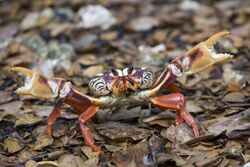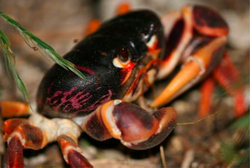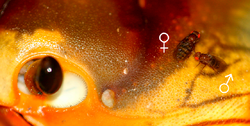Biology:Gecarcinus ruricola
| Gecarcinus ruricola | |
|---|---|

| |
| Scientific classification | |
| Domain: | Eukaryota |
| Kingdom: | Animalia |
| Phylum: | Arthropoda |
| Class: | Malacostraca |
| Order: | Decapoda |
| Suborder: | Pleocyemata |
| Infraorder: | Brachyura |
| Family: | Gecarcinidae |
| Genus: | Gecarcinus |
| Species: | G. ruricola
|
| Binomial name | |
| Gecarcinus ruricola | |
| Synonyms [2] | |
| |
Gecarcinus ruricola is a species of terrestrial crab. It is the most terrestrial of the Caribbean land crabs,[3] and is found from western Cuba across the Antilles as far east as Barbados. Common names for G. ruricola include the purple land crab,[1] black land crab,[3] red land crab,[4] and zombie crab.[5]
Description
Four colour morphs exist within the species - black, red, yellow, and green.[6] The carapace of G. ruricola grows in width at a rate of about 1 in (25 mm) per year, with the crabs reaching maturity after 5 years, and living for up to 10 years in total.[6] G. ruricola crabs have a number of adaptations to terrestrial life, mostly regarding water conservation. They are nocturnal, to prevent the hot sun from drying them out. They also have a "nephritic pad", onto which urine is released, to be cleaned by microbes before the water is then reabsorbed.[7]
Distribution
G. ruricola is found across much of the Caribbean, from Cuba and the Bahamas in the west through the Antilles to Barbados in the east. It has been reported from Florida and Nicaragua, but few confirmed examples exist from the mainland; Loggerhead Key in the Dry Tortugas marks the northernmost limit of its island distribution, which extends across the Bahamas and Cuba, through the Greater and Lesser Antilles, to Barbados. Outlying populations exist on Curaçao, in the Swan Islands off Honduras, Half Moon Caye of Belize, and the Archipelago of San Andrés, Providencia and Santa Catalina off the Colombian coast.[3]
It can be found at great distances from the sea, and at high altitudes; it has been observed above 300 m (980 ft) on the island of Dominica, and at over 1,000 m (3,300 ft) on Jamaica.[3]
Life cycle
The eggs of G. ruricola hatch in the sea,[6] where the larvae live as plankton. The return of the larvae to land seems to be infrequent, but when they do return, they return as megalopa larvae, in sufficient numbers to turn roads red.[8] They move at speeds of 1–2 m/s (2.2–4.5 mph), or faster if startled.[9] For the next three years, the young crabs live in burrows inhabited by other crabs, and eat food brought back to the burrow by the older crab.[6]
After mating, mass migrations occur, with the females returning to the sea to release their fertilised eggs. A typical female carries around 85,000 eggs.[8]
Ecology
G. ruricola is an omnivorous scavenger,[6] feeding mostly on nitrogen-poor plant matter.[8]
The meat of G. ruricola is rich in protein, and has often been harvested by local people. Other predators may include birds, although information is scarce. When confronted, they rear up and hold their open claws outwards in a defensive posture.[6]
Drosophila
G. ruricola is the host organism for two species of commensal flies in the genus Drosophila.[10] They were first observed on Montserrat by Henry Guernsey Hubbard in 1894, and presented at a scientific meeting later that year (where the crab was misidentified as Cardisoma guanhumi), but no further research was conducted until 1955, when specimens were again collected, this time from Mona Island, and named as Drosophila carcinophila by M. R. Wheeler.[11]
In 1967, a second species of fly, Drosophila endobranchia, was discovered on G. ruricola, although it also inhabits the closely related species G. lateralis. D. endrobranchia is not closely related to D. carcinophila, and this trait appears to have evolved convergently. (A third species of fly, Lissocephala powelli, has evolved a similar habit on Christmas Island, where it lives on the land crabs Gecarcoidea lalandii, Geograpsus crinipes, and Cardisoma carnifex, and the terrestrial hermit crab Birgus latro.) D. endobranchia evolved from a group of species that breeds on fungi or bark, while D. carcinophila evolved from a group that breeds on cacti.[10]
The flies spend most of their lives on the crab, and are reluctant to leave. They do not need to flee predators, because the crabs they inhabit are fast animals and will flee:[7]
The flies … hardly move at all, are extremely reluctant in leaving their host crabs and are hard pushed to take flight. Although the flies are sluggish, the crabs on which they reside are anything but. Chasing after crabs through a pitch-black jungle (growing on a razor-sharp labyrinthine limestone ground), while trying to aspirate flies from their carapaces is not trivial. Obtaining large amounts of flies in this way is simply a nightmare.
The eggs are laid around the crab's compound eyes; the first-instar larvae migrate to the crab's nephritic pad, and live there, feeding on the microbes that cleanse the crab's urine. The second instar is spent in the crab's gill chamber. The third instar has the larvae return to the mouthparts before falling to the ground to pupate.[7]
Linnaeus
Carl Linnaeus described the species in 1758 (the starting point for zoological nomenclature), noting the species' annual migrations from the forests to the coast (Habitat in America, sylvas vastissimis agminibus quotannis deserens littora maris petiturus: "lives in America; every year, an army marches out of the forests towards the sea").[12]
Philately
G. ruricola appeared on two African postage stamps for the International Year of the Ocean in 1998, under the name "mountain crab". These were a Tanzanian stamp worth TSh Template:Shilingi and a Ugandan stamp worth USh Template:Shilingi.[13]
References
- ↑ 1.0 1.1 "Gecarcinus ruricola". Integrated Taxonomic Information System. https://www.itis.gov/servlet/SingleRpt/SingleRpt?search_topic=TSN&search_value=99131.
- ↑ Peter K. L. Ng; Danièle Guinot; Peter J. F. Davie (2008). "Systema Brachyurorum: Part I. An annotated checklist of extant Brachyuran crabs of the world". Raffles Bulletin of Zoology 17: 1–286. http://rmbr.nus.edu.sg/rbz/biblio/s17/s17rbz.pdf.
- ↑ 3.0 3.1 3.2 3.3 Richard G. Hartnoll; Mark S. P. Baine; Yolima Grandas; Jennifer James; Helen Atkin (2006). "Population biology of the black land crab, Gecarcinus ruricola, in the San Andres archipelago, Western Caribbean". Journal of Crustacean Biology 26 (3): 316–325. doi:10.1651/C-2640.1.
- ↑ "Red land crab Gecarcinus ruricola". Spectrum of Life. American Museum of Natural History. http://www.amnh.org/exhibitions/hall_tour/spectrum/a769.html.
- ↑ M. Kettunen; P. Genovesi; S. Gollasch; S. Pagad; U. Starfinger; P. ten Brink; C. Shine (2008). Technical support to EU strategy on invasive species (IAS) - Assessment of the impacts of IAS in Europe and the EU (final module report for the European Commission). Brussels, Belgium: Institute for European Environmental Policy. pp. 44 + annexes. http://ec.europa.eu/environment/nature/invasivealien/docs/Kettunen2009_IAS_Task%201.pdf.
- ↑ 6.0 6.1 6.2 6.3 6.4 6.5 "Why do we see Crabs in the Quill?". St Eustatius: National and Marine Parks and Botanical Gardens Newsletter: 5. 2009. http://www.statiapark.org/downloads/downloads/newsletter/newsletter-sept09.pdf. Retrieved 2010-02-06.
- ↑ 7.0 7.1 7.2 Marcus C. Stensmyr; Regina Stieber; Bill S. Hansson (2008). Vosshall, Leslie B.. ed. "The Cayman Crab Fly Revisited — Phylogeny and Biology of Drosophila endobranchia". PLoS One 3 (4): e1942. doi:10.1371/journal.pone.0001942. PMID 18398468. Bibcode: 2008PLoSO...3.1942S.
- ↑ 8.0 8.1 8.2 Richard G. Hartnoll; Mark S. P. Baine; Arne Britton; Yolima Grandas; Jennifer James; Alejandro Velasco; Michael G. Richmond (2007). "Reproduction of the black land crab, Gecarcinus ruricola, in the San Andres Archipelago, Western Caribbean". Journal of Crustacean Biology 27 (3): 425–436. doi:10.1651/S-2772.1.
- ↑ Richard Hartnoll; Paul F. Clark (2006). "A mass recruitment event in the land crab Gecarcinus ruricola (Linnaeus, 1758) (Brachyura: Grapsoidea: Gecarcinidae), and a description of the megalop". Zoological Journal of the Linnean Society 146 (2): 149–164. doi:10.1111/j.1096-3642.2006.00195.x.
- ↑ 10.0 10.1 Hampton L. Carson (1974). "Three Flies and Three Islands: Parallel Evolution in Drosophila". Proceedings of the National Academy of Sciences 71 (9): 3517–3521. doi:10.1073/pnas.71.9.3517. PMID 4530320. Bibcode: 1974PNAS...71.3517C.
- ↑ Marcus C. Stensmyr; Bill S. Hansson (2007). "Flies' lives on a crab". Current Biology 17 (17): R743–R746. doi:10.1016/j.cub.2007.06.015. PMID 17803919.
- ↑ Carl Linnaeus (1758). "239. Cancer". Systema Naturae (10th ed.). Stockholm, Sweden: Laurentius Salvius. pp. 649–658. https://www.biodiversitylibrary.org/bibliography/542.
- ↑ Makoto Omori; Lipke B. Holthuis (2005). "Crustaceans on postage stamps from 1870 to and including 2002: revised article for our paper in 2000 and addendum". Journal of the Tokyo University of Marine Science and Technology 1: 1–39. http://lib.s.kaiyodai.ac.jp/library/kiyou/tkh01/tkh0101.pdf. Retrieved 2010-02-06.
Wikidata ☰ Q5233916 entry
 |




